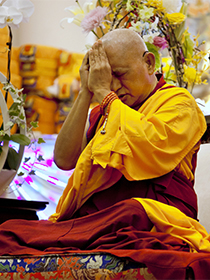- Home
- FPMT Homepage
Foundation for the Preservation of the Mahayana Tradition
The FPMT is an organization devoted to preserving and spreading Mahayana Buddhism worldwide by creating opportunities to listen, reflect, meditate, practice and actualize the unmistaken teachings of the Buddha and based on that experience spreading the Dharma to sentient beings. We provide integrated education through which people’s minds and hearts can be transformed into their highest potential for the benefit of others, inspired by an attitude of universal responsibility and service. We are committed to creating harmonious environments and helping all beings develop their full potential of infinite wisdom and compassion. Our organization is based on the Buddhist tradition of Lama Tsongkhapa of Tibet as taught to us by our founders Lama Thubten Yeshe and Lama Thubten Zopa Rinpoche.
- Willkommen
Die Stiftung zur Erhaltung der Mahayana Tradition (FPMT) ist eine Organisation, die sich weltweit für die Erhaltung und Verbreitung des Mahayana-Buddhismus einsetzt, indem sie Möglichkeiten schafft, den makellosen Lehren des Buddha zuzuhören, über sie zur reflektieren und zu meditieren und auf der Grundlage dieser Erfahrung das Dharma unter den Lebewesen zu verbreiten.
Wir bieten integrierte Schulungswege an, durch denen der Geist und das Herz der Menschen in ihr höchstes Potential verwandelt werden zum Wohl der anderen – inspiriert durch eine Haltung der universellen Verantwortung und dem Wunsch zu dienen. Wir haben uns verpflichtet, harmonische Umgebungen zu schaffen und allen Wesen zu helfen, ihr volles Potenzial unendlicher Weisheit und grenzenlosen Mitgefühls zu verwirklichen.
Unsere Organisation basiert auf der buddhistischen Tradition von Lama Tsongkhapa von Tibet, so wie sie uns von unseren Gründern Lama Thubten Yeshe und Lama Thubten Zopa Rinpoche gelehrt wird.
- Bienvenidos
La Fundación para la preservación de la tradición Mahayana (FPMT) es una organización que se dedica a preservar y difundir el budismo Mahayana en todo el mundo, creando oportunidades para escuchar, reflexionar, meditar, practicar y actualizar las enseñanzas inconfundibles de Buda y en base a esa experiencia difundir el Dharma a los seres.
Proporcionamos una educación integrada a través de la cual las mentes y los corazones de las personas se pueden transformar en su mayor potencial para el beneficio de los demás, inspirados por una actitud de responsabilidad y servicio universales. Estamos comprometidos a crear ambientes armoniosos y ayudar a todos los seres a desarrollar todo su potencial de infinita sabiduría y compasión.
Nuestra organización se basa en la tradición budista de Lama Tsongkhapa del Tíbet como nos lo enseñaron nuestros fundadores Lama Thubten Yeshe y Lama Zopa Rinpoche.
A continuación puede ver una lista de los centros y sus páginas web en su lengua preferida.
- Bienvenue
L’organisation de la FPMT a pour vocation la préservation et la diffusion du bouddhisme du mahayana dans le monde entier. Elle offre l’opportunité d’écouter, de réfléchir, de méditer, de pratiquer et de réaliser les enseignements excellents du Bouddha, pour ensuite transmettre le Dharma à tous les êtres. Nous proposons une formation intégrée grâce à laquelle le cœur et l’esprit de chacun peuvent accomplir leur potentiel le plus élevé pour le bien d’autrui, inspirés par le sens du service et une responsabilité universelle. Nous nous engageons à créer un environnement harmonieux et à aider tous les êtres à épanouir leur potentiel illimité de compassion et de sagesse. Notre organisation s’appuie sur la tradition guéloukpa de Lama Tsongkhapa du Tibet, telle qu’elle a été enseignée par nos fondateurs Lama Thoubtèn Yéshé et Lama Zopa Rinpoché.
Visitez le site de notre Editions Mahayana pour les traductions, conseils et nouvelles du Bureau international en français.
Voici une liste de centres et de leurs sites dans votre langue préférée
- Benvenuto
L’FPMT è un organizzazione il cui scopo è preservare e diffondere il Buddhismo Mahayana nel mondo, creando occasioni di ascolto, riflessione, meditazione e pratica dei perfetti insegnamenti del Buddha, al fine di attualizzare e diffondere il Dharma fra tutti gli esseri senzienti.
Offriamo un’educazione integrata, che può trasformare la mente e i cuori delle persone nel loro massimo potenziale, per il beneficio di tutti gli esseri, ispirati da un’attitudine di responsabilità universale e di servizio.
Il nostro obiettivo è quello di creare contesti armoniosi e aiutare tutti gli esseri a sviluppare in modo completo le proprie potenzialità di infinita saggezza e compassione.
La nostra organizzazione si basa sulla tradizione buddhista di Lama Tsongkhapa del Tibet, così come ci è stata insegnata dai nostri fondatori Lama Thubten Yeshe e Lama Zopa Rinpoche.
Di seguito potete trovare un elenco dei centri e dei loro siti nella lingua da voi prescelta.
- 欢迎 / 歡迎
简体中文
“护持大乘法脉基金会”( 英文简称:FPMT。全名:Foundation for the Preservation of the Mahayana Tradition) 是一个致力于护持和弘扬大乘佛法的国际佛教组织。我们提供听闻,思维,禅修,修行和实证佛陀无误教法的机会,以便让一切众生都能够享受佛法的指引和滋润。
我们全力创造和谐融洽的环境, 为人们提供解行并重的完整佛法教育,以便启发内在的环宇悲心及责任心,并开发内心所蕴藏的巨大潜能 — 无限的智慧与悲心 — 以便利益和服务一切有情。
FPMT的创办人是图腾耶喜喇嘛和喇嘛梭巴仁波切。我们所修习的是由两位上师所教导的,西藏喀巴大师的佛法传承。
繁體中文
護持大乘法脈基金會”( 英文簡稱:FPMT。全名:Found
ation for the Preservation of the Mahayana Tradition ) 是一個致力於護持和弘揚大乘佛法的國際佛教組織。我們提供聽聞, 思維,禪修,修行和實證佛陀無誤教法的機會,以便讓一切眾生都能 夠享受佛法的指引和滋潤。 我們全力創造和諧融洽的環境,
為人們提供解行並重的完整佛法教育,以便啟發內在的環宇悲心及責 任心,並開發內心所蘊藏的巨大潛能 — 無限的智慧與悲心 – – 以便利益和服務一切有情。 FPMT的創辦人是圖騰耶喜喇嘛和喇嘛梭巴仁波切。
我們所修習的是由兩位上師所教導的,西藏喀巴大師的佛法傳承。 察看道场信息:
- FPMT Homepage
- News/Media
-
- Study & Practice
-
-
- About FPMT Education Services
- Latest News
- Programs
- New to Buddhism?
- Buddhist Mind Science: Activating Your Potential
- Heart Advice for Death and Dying
- Discovering Buddhism
- Living in the Path
- Exploring Buddhism
- FPMT Basic Program
- FPMT Masters Program
- FPMT In-Depth Meditation Training
- Maitripa College
- Lotsawa Rinchen Zangpo Translator Program
- Universal Education for Compassion & Wisdom
- Online Learning Center
-
- Prayers & Practice Materials
- Overview of Prayers & Practices
- Full Catalogue of Prayers & Practice Materials
- Explore Popular Topics
- Benefiting Animals
- Chenrezig Resources
- Death & Dying Resources
- Lama Chopa (Guru Puja)
- Lama Zopa Rinpoche: Compendium of Precious Instructions
- Lama Zopa Rinpoche: Life Practice Advice
- Lama Zopa Rinpoche Practice Series
- Lamrim Resources
- Mantras
- Prayer Book Updates
- Purification Practices
- Sutras
- Thought Transformation (Lojong)
- Audio Materials
- Dharma Dates - Tibetan Calendar
- Translation Services
- Publishing Services
- Ways to Offer Support
- Prayers & Practice Materials
-
- Teachings and Advice
- Find Teachings and Advice
- Lama Zopa Rinpoche Advice Page
- Lama Zopa Rinpoche: Compendium of Precious Instructions
- Lama Zopa Rinpoche Video Teachings
- ༧སྐྱབས་རྗེ་བཟོད་པ་རིན་པོ་ཆེ་མཆོག་ནས་སྩལ་བའི་བཀའ་སློབ་བརྙན་འཕྲིན།
- Podcasts
- Lama Yeshe Wisdom Archive
- Buddhism FAQ
- Dharma for Young People
- Resources on Holy Objects
- Teachings and Advice
-
-
*If a menu item has a submenu clicking once will expand the menu clicking twice will open the page.
-
-
- Centers
-
- Teachers
-
- Projects
-
-
-
-
*If a menu item has a submenu clicking once will expand the menu clicking twice will open the page.
-
-
- FPMT
-
-
-
-
-
Basically, the human mind is mostly unconscious, ignorant, and gets so preoccupied with new experiences, that it forgets the old ones. Review the past month: exactly what happened, precisely what feelings did you have, every day? You can’t remember, can you? But if you practice this slowly, slowly, continuously checking within your mind, eventually, you’ll be able to remember more and more of your previous experiences.
Share
Lama Thubten Yeshe
-
-
-
- Shop
-
-
-
The Foundation Store is FPMT’s online shop and features a vast selection of Buddhist study and practice materials written or recommended by our lineage gurus. These items include homestudy programs, prayers and practices in PDF or eBook format, materials for children, and other resources to support practitioners.
Items displayed in the shop are made available for Dharma practice and educational purposes, and never for the purpose of profiting from their sale. Please read FPMT Foundation Store Policy Regarding Dharma Items for more information.
-
-
12
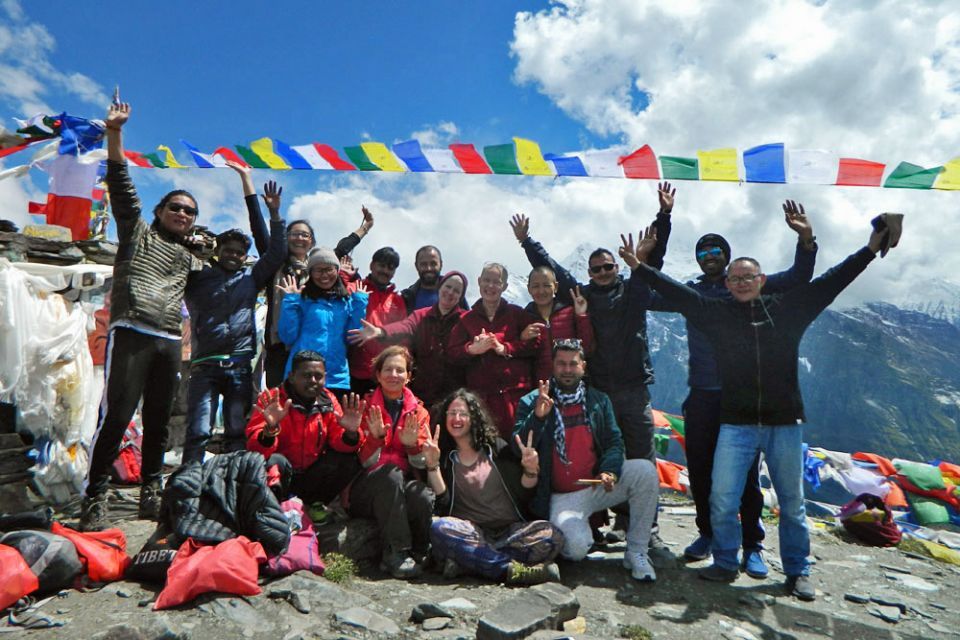
Drilbu Ri, Lahaul Spiti district, Himachal Pradesh, India, August 2019. Photo courtesy of Tushita Meditation Centre.
The FPMT resident teacher, staff members, and volunteers from Tushita Meditation Centre, the FPMT center in Dharamsala, Himachal Pradesh, India, went on pilgrimage to Lahaul (Garsha) in August 2019. The group traveled together in the Tushita bus and two additional vehicles on a route which included crossing the Rohtang Pass on the Leh-Manali Highway from Kullu district to the Lahaul Spiti district in Himachal Pradesh. Ven. Tenzin Kunphen, spiritual program coordinator, and Maria Nobuko Corrales, creative project assistant, share the story.
In August 2019, the Tushita staff did something remarkable following Lama Zopa Rinpoche’s advice. We closed our doors for a week and went on pilgrimage together! Our destination was Garsha, the Land of Dakinis (also known as Lahaul), in northern Himachal Pradesh, India. This spiritual adventure was filled with both trying and recurring obstacles that threatened our safety and caused some to turn back, but it was also filled with powerful blessings for those who endured!
This wasn’t the first time Tushita staff had traveled to Lahaul. In 2013, we were blessed to be invited by Lama Zopa Rinpoche to visit Lahaul, where Rinpoche did a private retreat in Triloknath together with Tsenshap Serkong Rinpoche and Khadro-la (Rangjung Neljorma Khadro Namsel Drönme). Tushita staff traveled with Rinpoche for two weeks. Then in 2015, following Rinpoche’s advice, the Tushita team went on pilgrimage for the first time, making a one-week pilgrimage to Lahaul.
In August 2019, our primary pilgrimage destinations were:
- Drilbu Ri Mountain—revered Chakrasamvara mountain, Palace of the Buddha’s Enlightened Body
- Phakpa Temple in Triloknath—revered Chenrezig statue and the Milky Chenrezig Lake (Omay Tso), Palace of the Buddha’s Enlightened Speech
- Markula Temple in Udaipur—revered Vajravarahi temple, Palace of the Buddha’s Enlightened Mind
On the way we visited:
- Sangam—the spot where the Chandra and Bhaga Rivers meet and unite together as Chandrabhaga River
- Tara Temple and Palden Lhamo waterfall near Sissu
- Padmasambhava caves and statue in Rewalsar (Tso Pema)
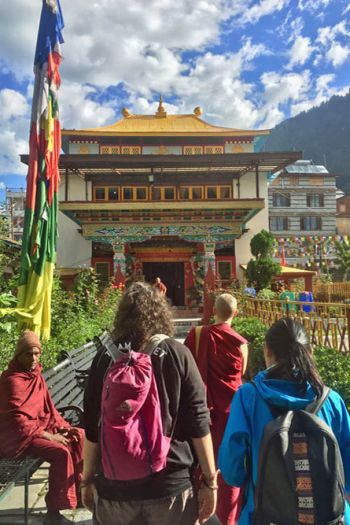
Manali, Kullu district, Himachal Pradesh, India, August 2019. Photo courtesy of Tushita Meditation Centre.
Through the Bardos
At 10 P.M. on August 18, nineteen of Tushita’s staff and volunteers loaded up into a bus and two additional vehicles to begin our long overnight drive to our first waypoint: Manali. Ginger tablets and Dramamine were washed down, strategically timed, along with prayers for effectiveness by those pilgrims susceptible to the destabilizing effect of the twists and turns promised by the road ahead. The hours of winding roads lived up to their reputation as a few meals reversed course, never completing their digestion, and others barely held on.
In the early still-dark hours of the next morning, just outside of Manali, we came to a halt. We were faced with a two-lane road that had crumbled to less than one, washed away by the heavy rains into the river below. Vinod, Tushita’s trusted driver who manned one of the vehicles, assessed the situation, uncertain if we could make it across. With a nagging feeling telling him “no” he reluctantly backed off, allowing the car that had come up behind us to make their choice.
As this new vehicle asserted its confidence in forging ahead, we all felt a wave of both relief and empathy as the car became stuck precisely where Vinod had a bad feeling. Reversing and attempting two hour-long detours before finally finding an alternate way through, all three Tushita cars reconvened in the light of a new day in Manali.
Before we could continue our ascent, we were required to obtain permits to go through Rohtang Pass, a high mountain pass at an elevation of 3,978 meters (13,050 feet), connecting the mostly Hindu Kullu valley below with the predominantly Buddhist Lahaul and Spiti high-altitude valleys above. With a history of dangerous conditions, Rohtang Pass literally translates to “corpse field.” Fortunately, most of the pilgrims were ignorant of that specific charming detail, and when our permit was denied that day due to landslides, we happily embraced a day to explore Manali.
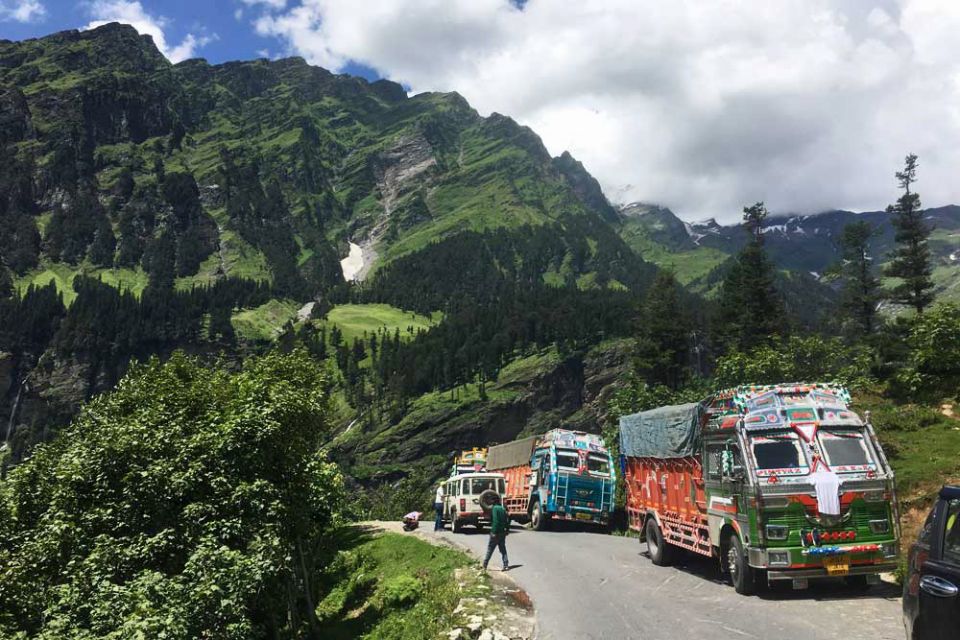
On the road from Manali to Rohtang Pass, Kullu district, Himachal Pradesh, India, August 2019. Photo courtesy of Tushita Meditation Centre.
With a good night’s sleep in comfortable hotel beds, breakfast in our bellies, and permits in hand, we piled back into the cars on August 20 to continue towards Rohtang Pass and beyond.
Now we were moving! Up and up we climbed, the air getting cleaner and thinner, and the mountains surrounding us becoming more majestic. With each turn of the road the views became more spectacular. Waterfalls decorated the green soaring mountains covered in a multitude of wildflowers.
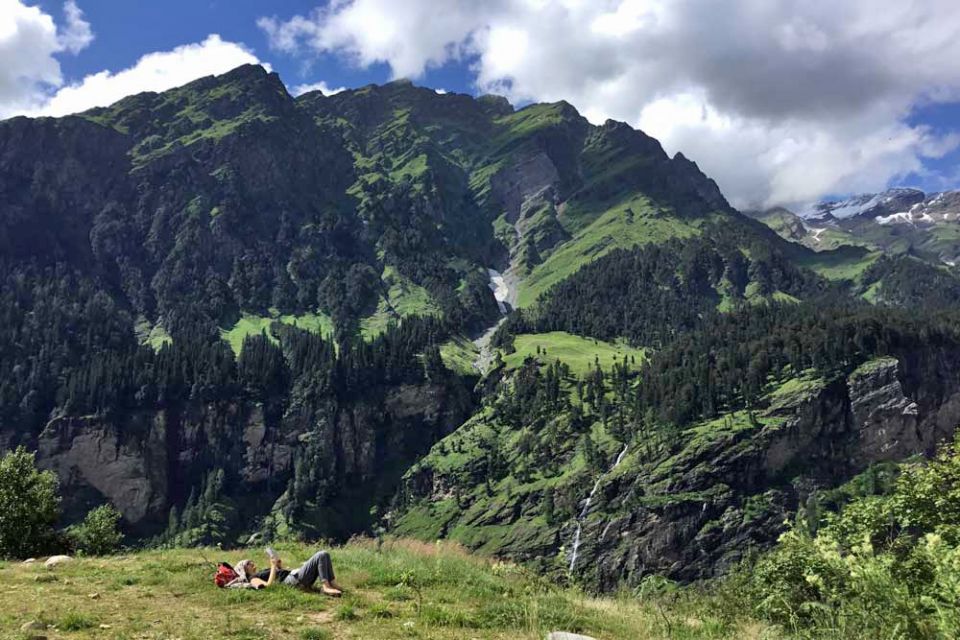
Outside of Manali on the way to Rohtang Pass, Kullu district, Himachal Pradesh, India, August 2019. Photo courtesy of Tushita Meditation Centre.
We turned a corner at 3,000 meters (10,000 feet) and hit the breaks. A long line of vehicles were at rest. Close inspection revealed that our predecessors had already been here for quite some time, stopped by a landslide far ahead. Our progress was halted!
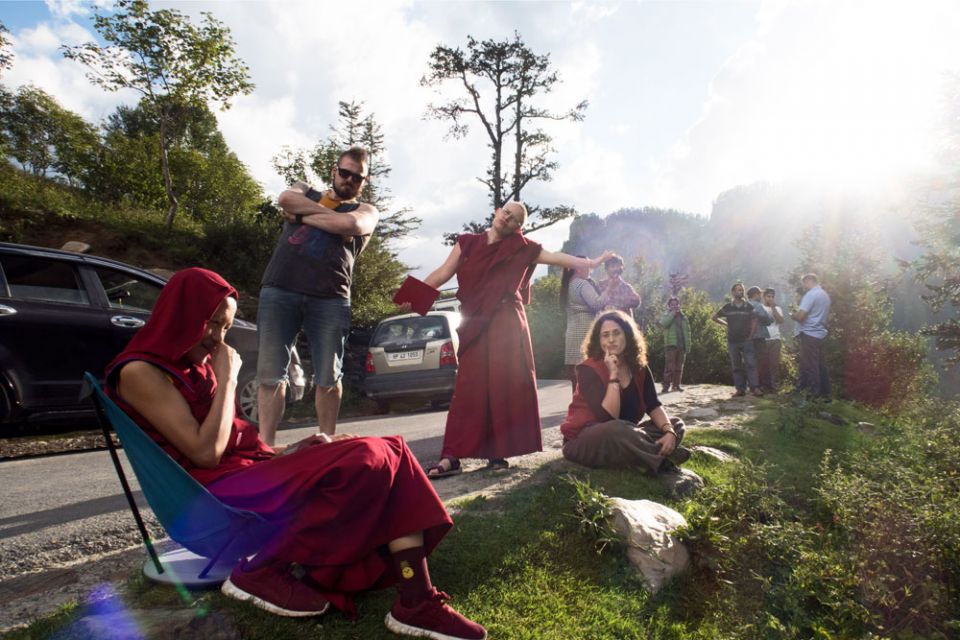
Progress halted on the road between Manali and Rohtang Pass, Kullu district, Himachal Pradesh, India, August 2019. Photo courtesy of Tushita Meditation Centre.
Camping on the alpine mountainside was not on the itinerary, yet I think we all embraced it as a marvelous gift. The sun shone (particularly precious after the monsoon we left behind), the view (again) was spectacular, and some astute entrepreneurs threw up tents and started selling chai, instant noodles, and omelets for the stranded hungry masses. All our needs were met!
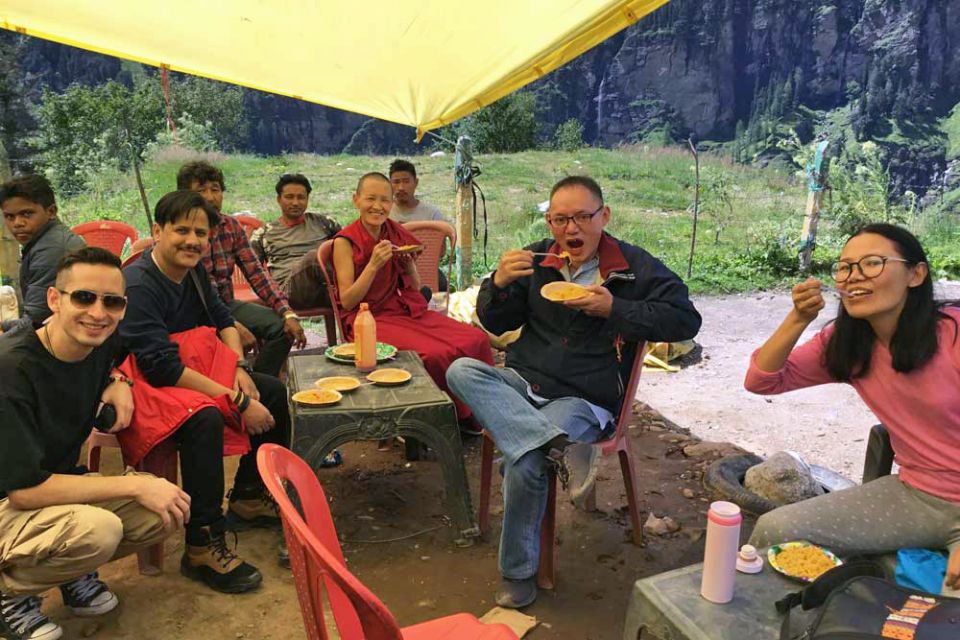
Chai, instant noodles, and omelets outside of Manali on the way towards Rohtang Pass, Kullu district, Himachal Pradesh, India, August 2019. Photo courtesy of Tushita Meditation Centre.
As the sweetness of the day began to fade with the setting sun and the chai shops disappeared just as they had miraculous appeared earlier, engines started and wheels began to roll. We were off again!
We climbed another 305 meters (1,000 feet) and passed through a dhaba [roadside restaurant] shanty town called Marhi. Its dhabas promised warm dinner with an indulgent array of options that extended beyond two items, but no, we were going to push on! Cover ground! Get. Through. That. Pass!
Onward we went, now in the darkness. Climbing, climbing, following the train of cars. As we were busy calculating what time we would now arrive at our next waypoint, we came to a temporary stop … which gradually revealed itself to be a temporary stop of the longer nature. Just as quickly as the wind of movement had filled our sails, it dropped out, and we were again sitting totally still on the mountainside. Another landslide.
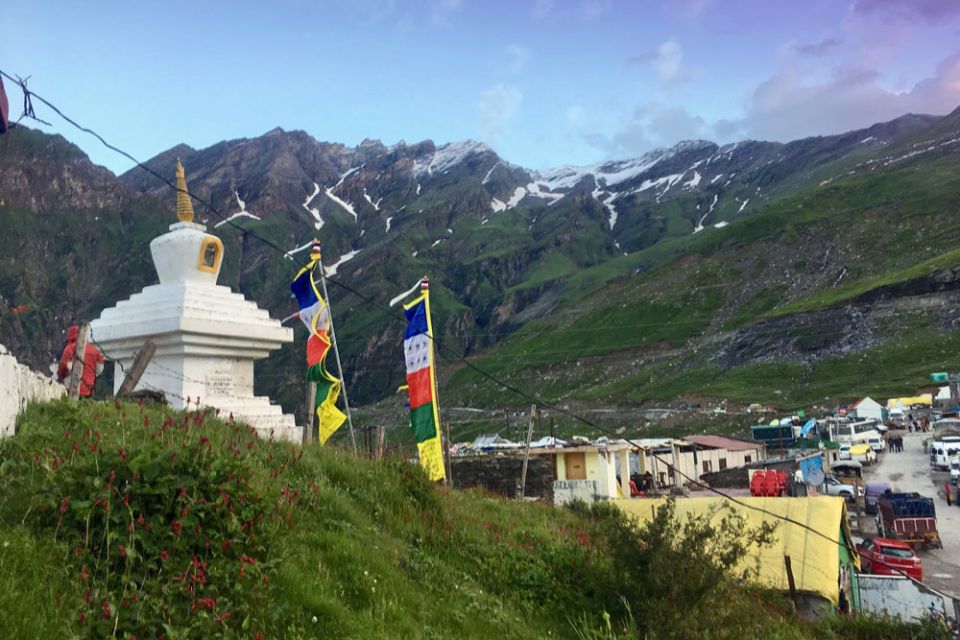
Marhi, Kullu district, Himachal Pradesh, India, August 2019. Photo courtesy of Tushita Meditation Centre.
Somewhat crestfallen, we surveyed the situation and decided to head back down the hill to Marhi where we could enjoy a late dinner and hopefully find some rooms to rent. The food renewed our spirits and bellies, and helped the news of “no rooms available” land a little softer. We all spent a night in a variety of contortions, with varying temperature regulation success in our respective vehicles. Those on the Tushita bus surely purified the most karma that night.
The morning of August 21 we reverse Tetris-ed ourselves out of our vehicles to see the snow-topped mountains that held us in their midst. At 3,360 meters (11,020 feet), we were fortunate for this extra time to acclimate our bodies to the lower oxygen levels, and some of us capitalized on this by hiking around to see more of the beautiful scenery and stimulate red blood cell production.
When the unmoving line of cars on the mountainside above finally began to move just before lunchtime, we jumped into the cars and sped up the hill to join the queue. We passed the point we had stopped at the night before and felt the satisfaction of gaining ground before turning the bend and finding ourselves stopped once again. The culprit? You guessed it. Another landslide.

Traffic between Marhi and Rohtang Pass, Kullu district, Himachal Pradesh, India, August 2019. Photo courtesy of Tushita Meditation Centre.
We found ourselves in a bardo state: having left but not yet having arrived. Just as we were in an in-between we realized the mountain itself was in its own bardo state—transitioning, changing, becoming something new—no longer the mountain it was, but not yet settled into the mountain it would become. We had no option but to honor the mountain’s process and use the time to honor our own.
Making the most of our bardo experience, we spent another day perched on the mountainside sharing snacks and soaking up the expansive views and warm rays of the sun. This time we weren’t far behind the slide. As the road looped back on the mountain above us we could see where the disruption had occurred; an enormous boulder obstructed the road.
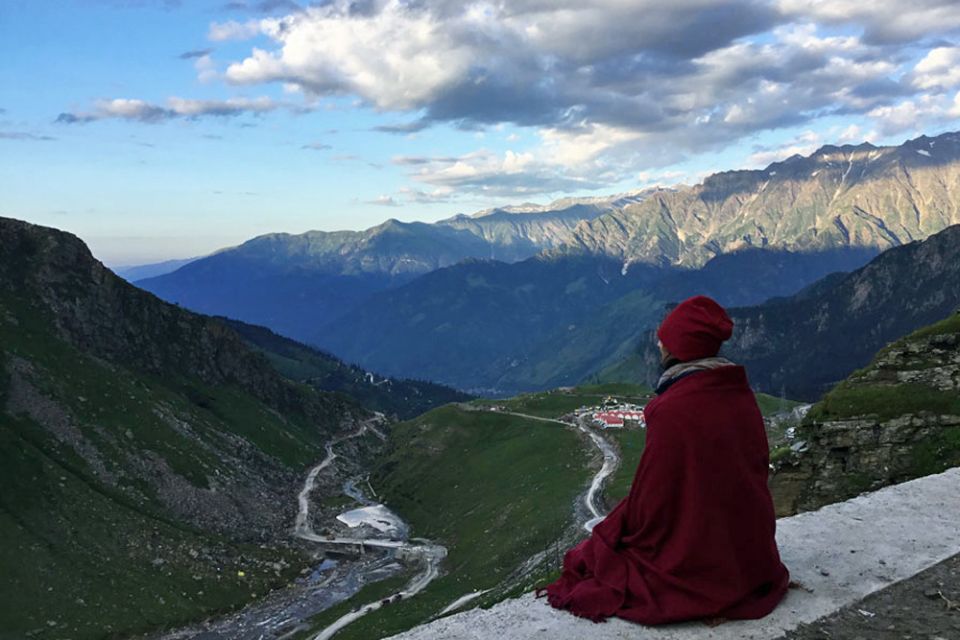
Taking in the view between Marhi and Rohtang Pass, Kullu district, Himachal Pradesh, India, August 2019. Photo courtesy of Tushita Meditation Centre.
Eventually we heard the startling boom of dynamite, and some time later we began to see the trucks that had been halted on their way down resume their journey through a one-lane pass that had been created. For well-over an hour these trucks rumbled past us in a seemingly unending stream as we awaited our turn with varying appearances of patience.
At some point, the unseen decision-maker deemed it was time to switch directions and allow those of us going up the mountain to have a turn. We were ecstatic! Engines started, gears were engaged, and we rolled forward the length of five cars before stopping again. What’s going on? Why aren’t we moving anymore? Say it with me now: “landslide.”
This continued in stops and starts until we made our way just behind the thwarting segment of road as darkness took hold. All movement halted. It was too dangerous to proceed. We would not get through that night. The promise of a real bed and warm meal dissolved as we realized we had no option but to sleep (once again) in our vehicles. Turning back to Marhi was not an option either.
It was at this point that a few stalwart pilgrims felt they could not continue. Four took their bags and headed back down the mountain on foot to catch buses back to Manali and then home. Other brave (and fit) members hiked down to Marhi, loaded up on fresh paranthas, and selflessly hiked back up the mountain in the darkness. Dinner arrived near midnight to our exhausted and hungry group trying to find a more comfortable arrangement of body parts for another night of car sleeping.
With the dawn came the tractor operators and renewed energy. Before too long, hardly trusting the reality of it, we drove through the troublesome tract and made our way finally up to Rohtang Pass on August 22.
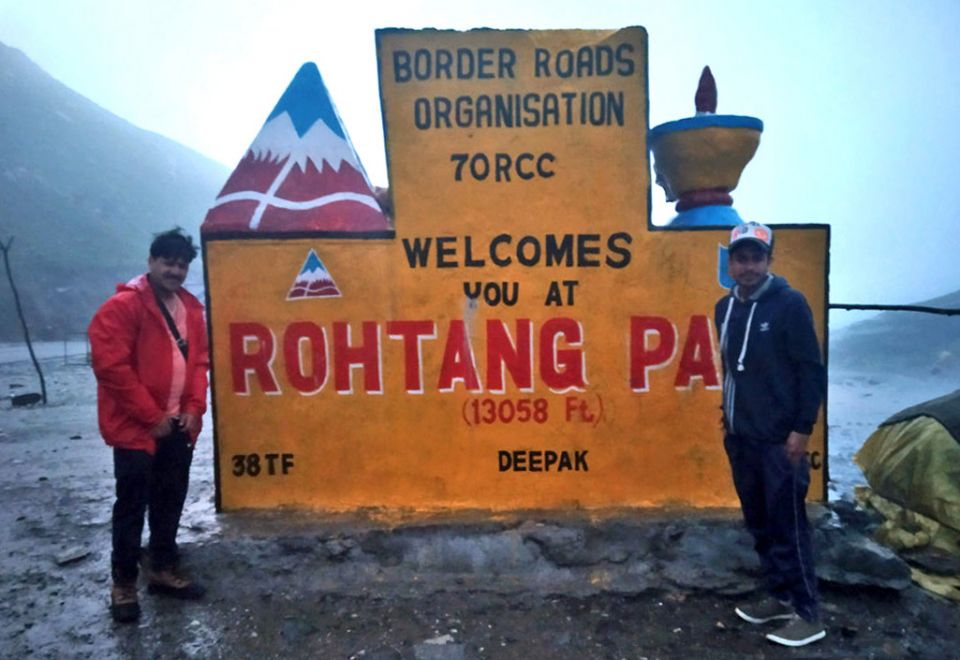
Rohtang Pass, connecting Kullu and Lahaul Spiti districts, Himachal Pradesh, August 2019. Photo courtesy of Tushita Meditation Centre.
After crossing Rohtang Pass and stopping to share our epic triumph with the local yaks and enjoy some snow, we went down, down, down the winding road into Lahaul Valley. Following the Chandra River, near the village of Sissu, we could see on the opposite side of the river the impressive Palden Lhamo waterfall, which is said to be a self-arisen manifestation of the Dharma protectress.
Not long after, another grand view greeted us: Sangam, a natural triangle that forms where the Chandra and Bhagra Rivers meet and become the Chandrabhaga (Chenab) River. The rivers Chandra and Bhaga first branch from the two sides of the Baralacha high mountain pass, then flow in opposite directions forming a circle, before finally meeting here again. This confluence is regarded as a holy place for Buddhists and Hindus alike.

Celebrating with yaks on the opposite side of Rohtang Pass, Lahaul Spiti district, Himachal Pradesh, India, August 2019. Photo courtesy of Tushita Meditation Centre.
We were now standing right at the foot of Drilbu Ri, or Heruka Mountain, our first pilgrimage destination. But before starting the climb the next morning, we were yearning to spend the night not in our car or bus, but in real beds again! Finding a hotel in Keylong, a small administrative town at the base of the mountain, we collapsed on our beds. We delighted in the sweetness of bathing, and rediscovered the alternate clothing items we vaguely remembered packing days earlier.
Drilbu Ri Mountain: The Palace of the Buddha’s Enlightened Body
Early on August 23, we headed to the sacred Drilbu Ri, the Mountain of Spontaneous Union, associated with Chakrasamvara. Traditionally said to be “the Palace of the Buddha’s Enlightened Body,” many realized practitioners have come here to meditate and receive its powerful blessings. These practitioners include the great master Nagarjuna and the legendary Mahasiddha Ghantapa.

Drilbu Ri, Lahaul Spiti district, Himachal Pradesh, India, August 2019. Photo courtesy of Tushita Meditation Centre.
Starting near Kardang Gompa, we passed through fields of medicinal pink and red flowers as we climbed ever higher in the thin air, working our way with much effort toward the peak. Under the cover of the misty morning, the fifteen of us (along with a group of Spanish pilgrims led by our former co-director Kiko Llopis) began our slow but steady circumambulation (or kora) of the sacred mountain, basking in its purifying and wish-fulfilling vibrations.
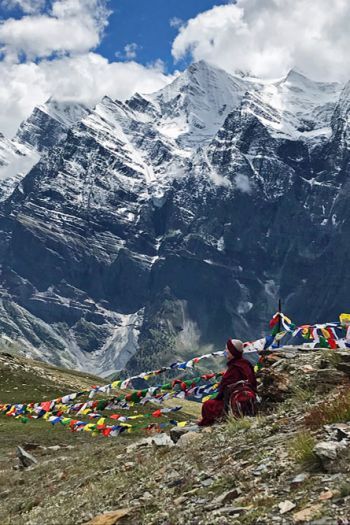
Drilbu Ri, Lahaul Spiti district, Himachal Pradesh, India, August 2019. Photo courtesy of Tushita Meditation Centre.
One could easily imagine the times when villagers, as mentioned in pilgrimage guide book Garsha, Heart Land of Dakinis, would regularly tell of hearing “music emanating miraculously from the mountainside, as if divine beings were engaging in sacred rituals.”
After five hours we reached the summit at 4,420 meters (14,500 feet), exhausted and happy, following in the footsteps of many great modern masters such as His Holiness the Dalai Lama, His Holiness the Sakya Trizin, and His Holiness the Gyalwang Drukpa. We offered incense, prayer flags, and prayers from our heart, said to definitely be fulfilled in such a powerful place as this.
We completed our kora with the inevitable descent, testing the vitality of our knees while feeling deeply satisfied. One could almost imagine the sky around us filled with dakinis offering their blessings. We felt that deep purification had surely taken place in making pilgrimage and kora at such a holy mountain, described by His Holiness the Gyalwang Drukpa as having three times the merit as a kora of Mount Kailash in Tibet!
A good night’s sleep in Keylong helped restore our bodies after climbing the equivalent of 255 flights of stairs. Refreshed, we were ready to continue to our next destination: Phakpa, the Unequalled Abode of Compassion, in Triloknath.

Drilbu Ri, Lahaul Spiti district, Himachal Pradesh, India, August 2019. Photo courtesy of Tushita Meditation Centre.
However, first we had to overcome a few more obstacles. Due to the landslides there was no gasoline available for our vehicles and the only public bus was hopelessly full to the brim. But as we know, the more hardships on a pilgrimage, the more merit! Somehow, we overcame the challenges of the morning and could finally continue on.
Phakpa Temple: The Palace of the Buddha’s Enlightened Speech
Triloknath is a tiny village in the Chandrabhaga valley. Archaic structures with low ceilings and full of character line the two brief paths that make up the town. One easily feels transported to another century. Locals say the relatively large building in the center, the former residence of the local king, is 1,000 years old. The original settlement is thought to have been founded by Nagarjuna himself. Archaeological evidence suggests Buddhism has been flourishing here since the second century C.E.
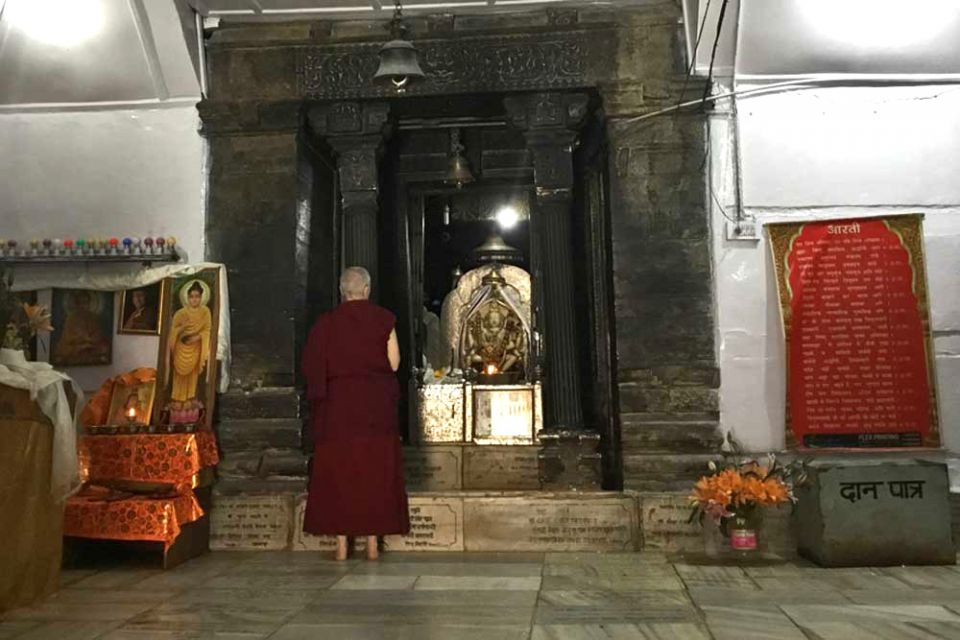
Phakpa Temple, Triloknath, Lahaul Spiti district, Himachal Pradesh, India, August 2019. Photo courtesy of Tushita Meditation Centre.
We now headed to the Phakpa Temple, which is dedicated to Chenrezig. The temple was built in the late ninth or early tenth century C.E. after the miraculous appearance of a white marble statute of Chenrezig with Amitabha Buddha at his crown.
Lama Zopa Rinpoche explained the importance of Phakpa and this Chenrezig statue to Ven. Sarah Thresher and others. Read Rinpoche’s explanation in Continuous Light Offered to Chenrezig.
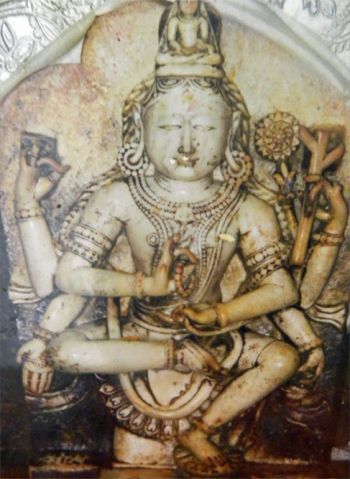
Phakpa Chenrezig in the Phakpa Temple, Triloknath, Lahaul Spiti district, Himachal Pradesh, India, August 2019. Photo courtesy of Tushita Meditation Centre.
The statue is believed to be imbued with extraordinary blessings, renowned for miraculously seeping nectar in the late 1930s and again in 1964. It is also known for its power of fertility, for which pilgrims come from afar. As we gathered in the cool refuge of this ancient temple, making offerings and heartfelt prayers, the power of this place resonated deeply. One felt that prayers made here with sincere motivation, devotion, and universal compassion had unmistakable power. How fortunate we were to receive such active and vibrant blessings from Phakpa Chenrezig! It is no wonder it is known as the Unequalled Abode of Compassion!
Walking around the tiny village and the temple, we could still see and feel the blessings of Lama Zopa Rinpoche from his visit in 2013. Villagers greeted our driver, Vinod, like an old friend. They showed us were Rinpoche, together with Tsenshap Serkong Rinpoche and Khadro-la, had stayed back then in a private retreat. When we visited the temple we saw Chenrezig praises written by Rinpoche, framed and hung up in Tibetan, Hindi, and English. These brought up memories of long days spent translating and framing the praises, and several trips to have them hung up by the temple management.
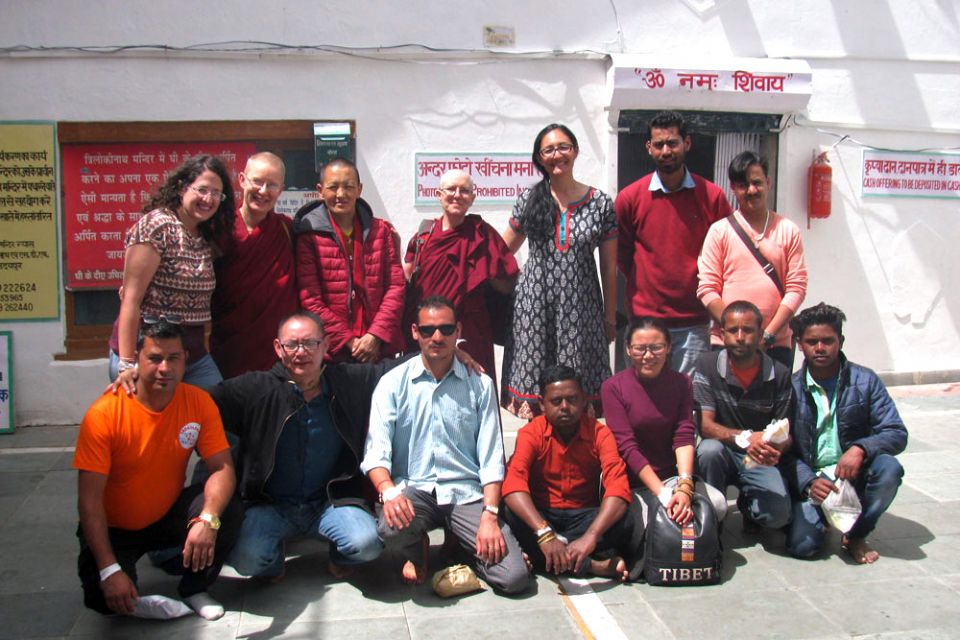
Triloknath, Lahaul Spiti district, Himachal Pradesh, India, August 2019. Photo courtesy of Tushita Meditation Centre.
Visitors entering the village of Triloknath are greeted by a golden rock covered in mantras painted by Lama Zopa Rinpoche.
We would have loved to have stayed in Triloknath longer and visited Omay Tso (the Milky Chenrezig Lake), a challenging but very rewarding day trip into the mountains. The white water from the lake is said to be blessed and can be enjoyed in many places around the area and the temple. However, this time we had to hurry on.
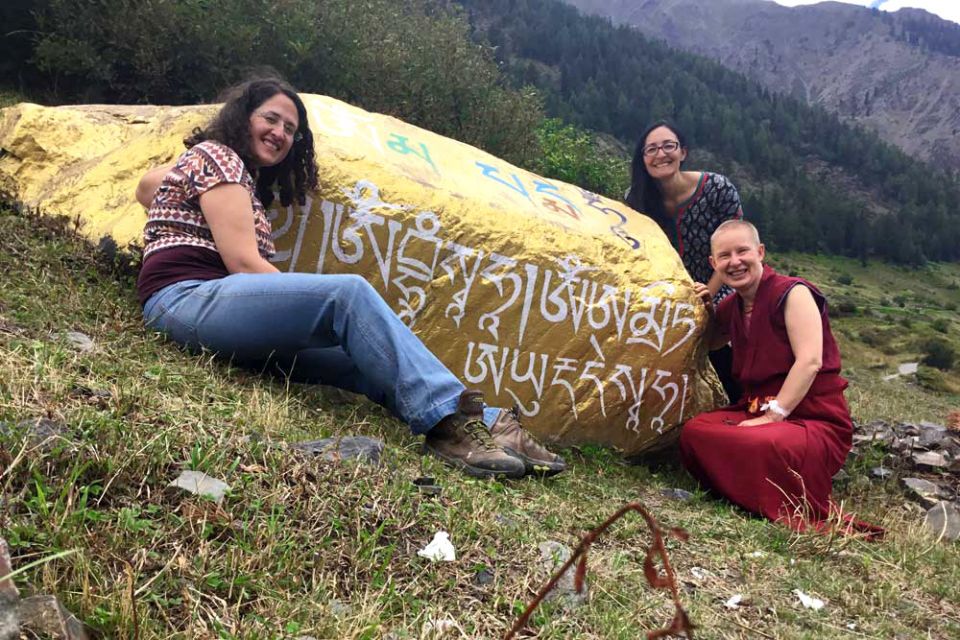
Amitayus mantra-covered rock painted by Lama Zopa Rinpoche, Triloknath, Lahaul Spiti district, Himachal Pradesh, India, August 2019. Photo courtesy of Tushita Meditation Centre.
Markula Temple: The Palace of the Buddha’s Enlightened Mind
Continuing on, we drove to Udaipur, in ancient times called Maru/Markula/Margul. Markula Temple, the “Great Tantric Site of the Underground Dakinis,” is in Udaipur. This is one of the twenty-four abodes of dakinis in our world as described in many tantras. Each abode is associated with a part of the human body. They are places of divine power, profound blessings for pilgrims, and swift enlightenment for yogis. Markula is connected to the big toes of the Vajra Kaya. This is the realm of the Underground Dakinis presided over by Vajrayogini.
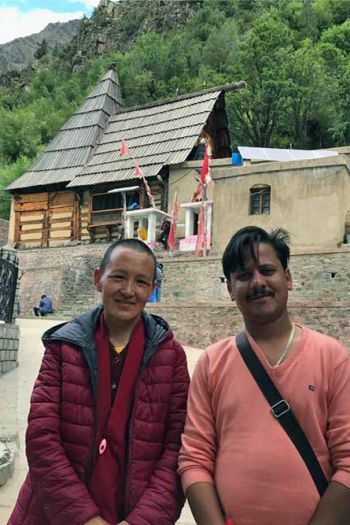
Markula Temple, Udaipur, Lahaul Spiti district, Himachal Pradesh, India, August 2019. Photo courtesy of Tushita Meditation Centre.
To our great disappointment the “cable-way” over the river, which we had so much enjoyed and feared from our previous visit in 2015, had been replace by a solid bridge. Passing the dakini footprint embedded in solid rock and the “heavy stone” of the Buddha’s toe outside, we entered the ancient shrine, allowing our eyes to adjust to the darkness of the room.
The temple is carved from darkened wood, the air filled with incense. We knelt, making heart-felt prayers, encouraged by Naropa’s message that this place, like the other twenty-three power places, is one of particular support to the liberation of spiritually immature practitioners such as ourselves. The pilgrimage guide book Garsha, Heart Land of Dakinis mentions that by visiting these sites and worshiping properly, practitioners can have their “unhappiness, delusions, and obstacles … supremely dispelled.”
Following in the footsteps of several of the eighty-four Indian mahasiddas who meditated here in the eighth to eleventh centuries C.E. and countless advance tantric practitioners who followed them, we made our offerings and prayers. This was a particularly auspicious time to invoke the protection and blessings of Tara and other feminine Buddhas inseparable from Vajrayogini, and we did our best before the temple steward made clear he wanted us to leave! Some of us finished our prayers on the bench outside, hoping to have our subtle energies blessed by the countless dakas and dakinis in residence here.
Filled to the brim and beyond with blessings, we happily piled back into the vehicles to begin our journey back to Manali. This time, all the obstacles were removed. We made it up and over Rohtang Pass with only the slightest delay to quickly clear rocks out of the road in the rain. We slept at a hotel in Manali that night, with one final destination awaiting us the following day.

Markula Temple is on the far left, Udaipur, Lahaul Spiti district, Himachal Pradesh, India, August 2019. Photo courtesy of Tushita Meditation Centre.
Tso Pema
On August 25, we made one final stop on our return trip home. About a five-hour drive from Tushita, in Mandi district, Tso Pema is a small mountain town centered around Rewalsar Lake. It is famous for being the place where Padmasambhava spent months in a cave practicing long life practices with the royal princess. The king, angered by this, tied the two of them to a funeral pyre and set them ablaze. But rather than being burned, Padmasambhava miraculously transformed the fire into a lake in which he was found sitting atop a lotus in the center with the princess, unharmed.
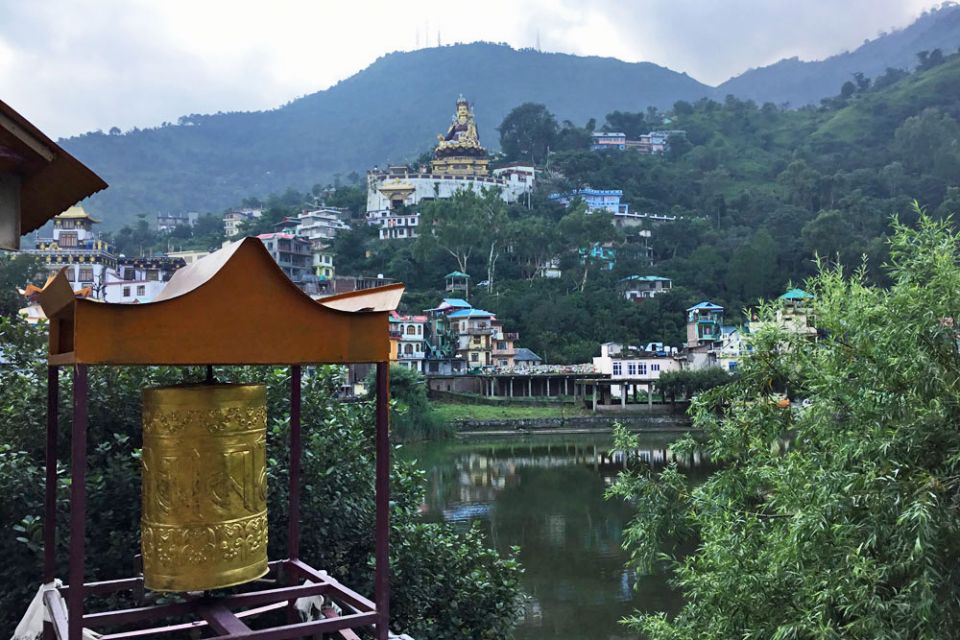
Tso Pema, Mandi district, Himachal Pradesh, India, August 2019. Photo courtesy of Tushita Meditation Centre.
Today, pilgrims circumambulate Rewalsar Lake beneath an enormous statue of Padmasambhava and visit the caves in which he meditated. We gathered in the main cave, where we made a special tsog offering and prayers. It was a joyful culmination of our incredible journey together.
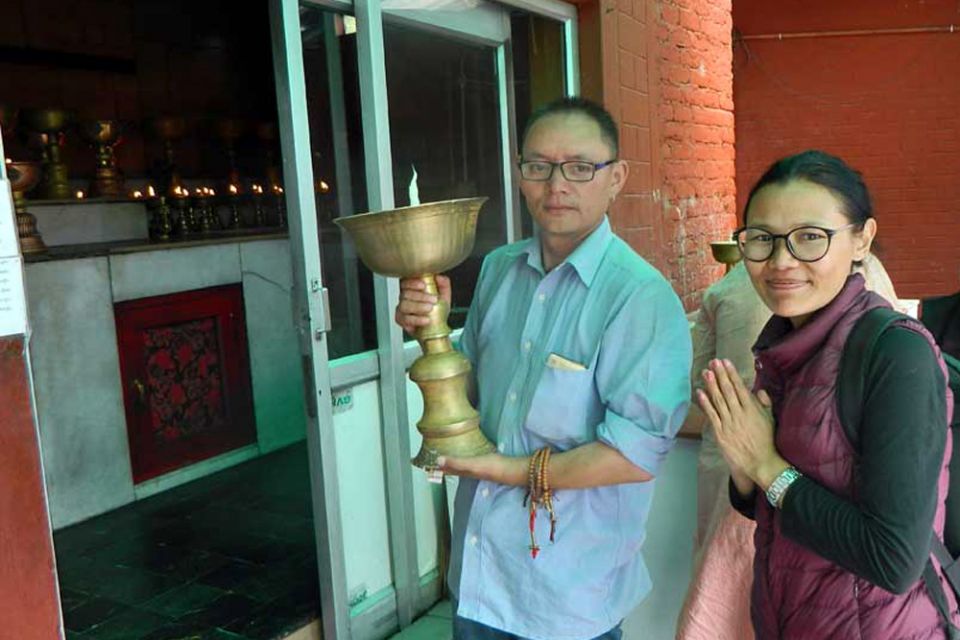
Tso Pema, Mandi district, Himachal Pradesh, India, August 2019. Photo courtesy of Tushita Meditation Centre.
We are deeply deeply grateful to all who made it possible for us to take this profound pilgrimage together. We dedicate all the merit we received that the Dharma wishes of our teachers, such as His Holiness the Dalai Lama and Lama Zopa Rinpoche, may succeed immediately, and that we may fully develop our positive qualities to be of greatest benefit to all beings in this and all future lives.
First published on Tushita Meditation Centre’s website: http://tushita.info/news/pilgrimage2019/
Written by Tushita Meditation Centre staff and referring to Garsha, Heart Land of Dakinis published by Garsha Young Drukpa Association, Keylong, 2011.
In 2014, Lama Zopa Rinpoche wrote a letter to an international Buddhist organization concerning care of the Chenrezig statue in the Phakpa Temple in Triloknath, published on the Lama Yeshe Wisdom Archive website: https://www.lamayeshe.com/advice/care-chenrezig-statue-garsha-india
For more information about Tushita Meditation Centre, visit their website:
http://tushita.info/
- Tagged: drilbu ri, francisco llopis, in-depth stories, khandro kunga bhuma, lahaul spiti, lama zopa rinpoche, manali, maria nobuko corrales, pema wangmo, pilgrimage, rohtang pass, serkong tsenshab rinpoche, triloknath, tso pema, tushita meditation centre, udaipur, ven. sarah thresher, ven. tenzin drolma, ven. tenzin kunphen
- Home
- News/Media
- Study & Practice
- About FPMT Education Services
- Latest News
- Programs
- New to Buddhism?
- Buddhist Mind Science: Activating Your Potential
- Heart Advice for Death and Dying
- Discovering Buddhism
- Living in the Path
- Exploring Buddhism
- FPMT Basic Program
- FPMT Masters Program
- FPMT In-Depth Meditation Training
- Maitripa College
- Lotsawa Rinchen Zangpo Translator Program
- Universal Education for Compassion & Wisdom
- Online Learning Center
- Prayers & Practice Materials
- Overview of Prayers & Practices
- Full Catalogue of Prayers & Practice Materials
- Explore Popular Topics
- Benefiting Animals
- Chenrezig Resources
- Death & Dying Resources
- Lama Chopa (Guru Puja)
- Lama Zopa Rinpoche: Compendium of Precious Instructions
- Lama Zopa Rinpoche: Life Practice Advice
- Lama Zopa Rinpoche Practice Series
- Lamrim Resources
- Mantras
- Prayer Book Updates
- Purification Practices
- Sutras
- Thought Transformation (Lojong)
- Audio Materials
- Dharma Dates – Tibetan Calendar
- Translation Services
- Publishing Services
- Teachings and Advice
- Find Teachings and Advice
- Lama Zopa Rinpoche Advice Page
- Lama Zopa Rinpoche: Compendium of Precious Instructions
- Lama Zopa Rinpoche Video Teachings
- ༧སྐྱབས་རྗེ་བཟོད་པ་རིན་པོ་ཆེ་མཆོག་ནས་སྩལ་བའི་བཀའ་སློབ་བརྙན་འཕྲིན།
- Podcasts
- Lama Yeshe Wisdom Archive
- Buddhism FAQ
- Dharma for Young People
- Resources on Holy Objects
- Ways to Offer Support
- Centers
- Affiliates Area
- Teachers
- Projects
- Charitable Projects
- Make a Donation
- Applying for Grants
- News about Projects
- Other Projects within FPMT
- Support International Office
- Projects Photo Galleries
- Give Where Most Needed
- FPMT
- Shop
Translate*
*powered by Google TranslateTranslation of pages on fpmt.org is performed by Google Translate, a third party service which FPMT has no control over. The service provides automated computer translations that are only an approximation of the websites' original content. The translations should not be considered exact and only used as a rough guide.Unlike an external enemy, the inner enemy cannot regroup and launch a comeback once it has been destroyed from within.







